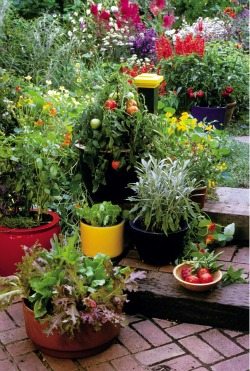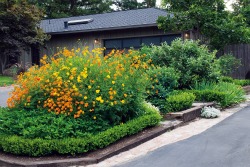
Your edible landscape can be as simple as colorful lettuces and tomatoes beautifully arranged in containers.

Ros Creasy has been promoting and writing about edible landscaping for more than 30 years. Her new book is loaded with great information on how to transform your yard into an edible paradise.
Long before heirloom vegetables graced catalogs, long before "locavore" became a household term, long before organic gardening was accepted as a mainstream concept, long before this latest wave of passion about vegetable, fruit and herb gardening, there was Ros Creasy and her edible landscape.
Ros has been the champion of edible landscaping for more than 30 years. Starting with her seminal work, The Complete Guide to Edible Landscaping, (Sierra Club Books, 1982), she highlighted the beauty, diversity and functionality of edibles in the landscape before it was trendy and cool. As Lynne Rossetto Kasper, host of The Splendid Table®, public radio’s national food show, has said, "Ros Creasy was so far ahead of the curve, we didn’t even know the curve existed."
Using her 1/4 acre house lot in Los Altos, California as a living laboratory, Ros planted all types of fruit trees, berry bushes, vegetables, herbs and edible flowers with an eye not only to food production, but also functionality and beauty in the landscape. She has spoken around the country about edible landscaping and helped design edible gardens in homes and public institutions such as the New York Botanical Garden and Powell Gardens in Kansas City, Missouri.
I've been fortunate to know Ros and her work for years, harkening back to my days at the National Gardening Magazine where we featured her amazing edible gardens.
With the release of an updated version of her book, Edible Landscaping (Sierra Club Books, 2010), I thought this the perfect time to catch up with this visionary and ask her about the new edition of her book and her thoughts on the edible landscaping movement.
Charlie: You've had the unique advantage of seeing the edible landscaping movement grow from infancy to adulthood over the past 30 years. How has the audience changed over the years?
Ros: When I give talks around the country, I've noticed how the audience interested in edible landscaping has gotten younger and more ethnically diverse. When I began it was mostly an older crowd of white people that would come to my talks. But that's changed. For example, I gave a talk recently at a local horticultural society. Normally they have maybe 40 people come to their talks with the average age about 75 years old, it seems. The night I gave the talk, they had more than 200 people show up with an average age of 35 years old.
Charlie: What's drawing this younger audience to edible landscaping?
Ros: Certainly the economy is driving people to look for ways to save money. Growing some of your own food is a very approachable thing to do to help balance a family's tight budget. But also environmental awareness has been instilled in the younger generation after years of environmental education. Young people are disgusted with large lawns and pesticide usage. They're not interested in plants as a trophy pieces for a collection, for entertainment or for status. They're interested in plants for very utilitarian purposes.
Edible landscaping also has grown hand in hand with a greater awareness and interest in good cooking and healthy eating. Good eating has taken on a celebrity status with the explosion of cookbooks, cooking shows and cooking competitions. I believe this all points to a cultural shift that's happening in our country with an emphasis on healthy, organically-raised foods free from pesticides.
Charlie: So when you were revising your book, were there sections that you removed or dramatically changed to reflect this cultural shift?

These blackberry canes drape over a wall dripping fruit onto an outdoor table.

Even an island between driveways can be transformed into a beautiful edible landscape with flowers, peanuts, and a lemon tree.

Mixing attractive greens, such as red mustard, kale, and bok choi, among your perennial flower border is a good way to use edibles in a flower garden.
Ros: Yes, I found that I didn't have to explain some basic concepts as I did in the first edition of the book. Recycling, organic gardening, and the problems with chemical pesticides are all widely understood and known now. I wrote this edition with the assumption that people know about and are interested in organic gardening already. I didn't have to spend as much time explaining why people should grow edibles in their landscape. People are already on board that train. I used the history of edible landscaping not to justify that this isn't a new concept, but to show ways that it can be done.
Charlie: At the same time, what did you add to this new edition to reflect this change?
Ros: I put a stronger emphasis on unique new varieties such as 'Perpetual Pesto' basil (which has aromatic and tasty variegated leaves but no flowers) and heirloom varieties. In the 1980's heirlooms were just starting to become widely available for purchase. Now they are everywhere. Even the ornamental plant company giant, Monrovia Nursery, has announced they are adding 22 new fruits to their 2011 line of plants. Plant breeders are now realizing that you can select plants for beauty and edibility without sacrificing either. The broader vision of plant varieties is coming from the fruit growers, too. One of the largest fruit tree growers in the country, Dave Wilson Nursery, now has a category in their catalog called "The most beautiful fruit trees".
I expanded and updated the variety listings, adding not only many more heirlooms, but also varieties from around the world. As our cooking and eating has become more influenced by different cultures, so too has the garden. You can grow varieties from almost any country of the world now.
I also added and updated lots of information on organic techniques, specifically organic pesticides. There are a lot more choices for home gardeners now to control pests organically. Serenade organic fungicide is a good example of a new breed of pesticide that's safer for the environment, yet effective against hard to control diseases such as powdery mildew. There's more information on soil preparation and care. I wanted to talk more about soil microbes and the key role they play in soil health.
Charlie: So where do you see the edible landscaping movement going in the future?
Ros: I see a continued change in the agriculture and gardening industries in this country. More organic techniques will be developed to combat pests in a safer way. There will be less an emphasis on the status symbol of a big lawn, large house or huge yard and more about an integrated landscape that caters to people, wildlife and the community. For most of the world, edible gardening already has this status. We're still learning here.
Food preservation such as canning is on the way back and our food choices will continue to diversify with our population.
Charlie: Any specific predictions?
Ros: Sure. Cider apples are going to make a comeback. A few hundred years ago, apples were grown for cider and there were different flavored apples and mixes to make different flavored ciders. I can see more apples being grown for their cider-making, as well as their fresh eating qualities.
Edible Landscaping has 432 pages of practical how-to information on growing a beautiful edible landscape. There are more than 300 color photos, 7 garden plans, and 20 black and white drawings, along with sections on designing with vegetables, fruits, herbs, and in small spaces. Plus, there's a vast encyclopedia of edibles that takes up the bulk of the book. Treat yourself to this book this winter!
 Charlie Nardozzi is an award winning, nationally recognized garden writer, speaker, radio, and television personality. He has worked for more than 30 years bringing expert gardening information to home gardeners through radio, television, talks, tours, on-line, and the printed page. Charlie delights in making gardening information simple, easy, fun and accessible to everyone. He's the author of 6 books, has three radio shows in New England and a TV show. He leads Garden Tours around the world and consults with organizations and companies about gardening programs. See more about him at Gardening With Charlie.
Charlie Nardozzi is an award winning, nationally recognized garden writer, speaker, radio, and television personality. He has worked for more than 30 years bringing expert gardening information to home gardeners through radio, television, talks, tours, on-line, and the printed page. Charlie delights in making gardening information simple, easy, fun and accessible to everyone. He's the author of 6 books, has three radio shows in New England and a TV show. He leads Garden Tours around the world and consults with organizations and companies about gardening programs. See more about him at Gardening With Charlie.
 Victory Seed Company has all the seeds you want for your best garden in 2024.
Victory Seed Company has all the seeds you want for your best garden in 2024.
For 25 years, the family-owned Victory Seed Company has provided the highest quality vegetable, herb and flower seeds to families across the country. We are passionate about providing you the best seeds available that give excellent germination, robust plants, and the harvest you want. With a catalog of over a thousand varieties, we have everything, and our prices are the kinds that we'd want to pay. We have hundreds of yesterday's heirloom vegetables, as well as today's award winning hybrid selections. Get to know us by visiting our website and browsing through our online vegetable seed catalog.